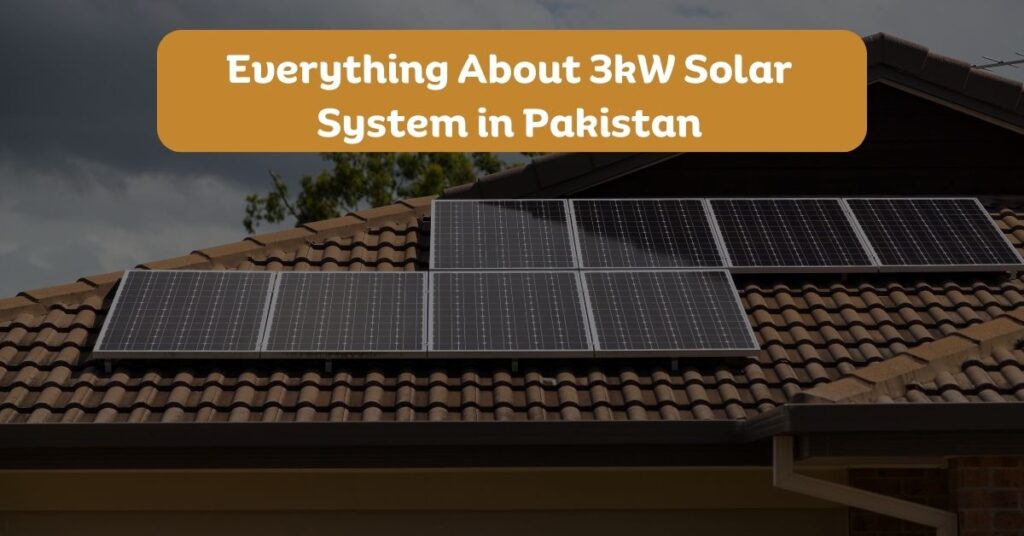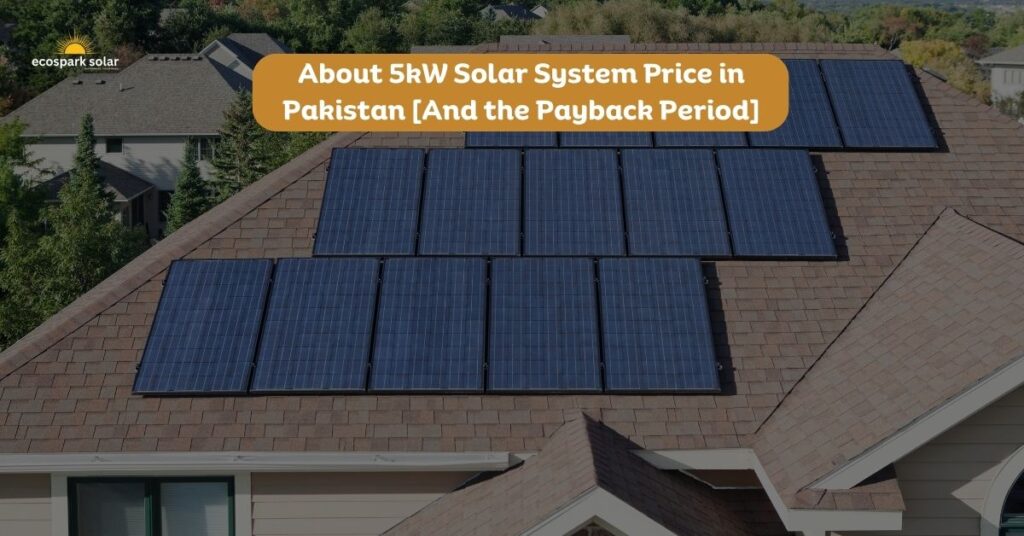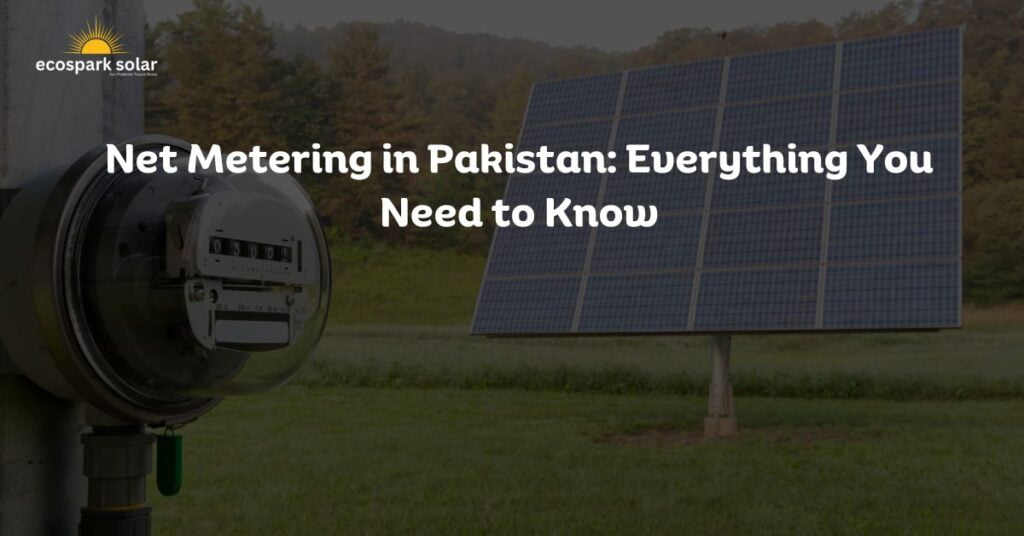In Pakistan, a country blessed with abundant sunlight throughout the year, solar power holds immense potential for sustainable and clean electricity generation. However, harnessing the full benefits of solar energy requires careful consideration of various factors, including the title angle (which also goes by elevation or orientation angle) and direction (or azimuth angle) at which solar panels are installed.
And why not? Positioning your solar panels at the right tilt angle and in the right direction determines the consumption of your system. This, in turn, affects the payback period of your system.
This article aims to provide everything you need to know about calculating the best angle and direction for solar panel installation in Pakistan.
Specifically, we will talk about the following:
- What is the title angle (or elevation angle) for solar panels?
- What is meant by direction (or azimuth angle)?
- What is the best title angle for solar panels in Pakistan?
- Factors to consider while calculating your system’s orientation angle (tilt angle).
- What is the best direction for installing solar panels in Pakistan?
And more.
Understanding the Tilt Angle and Direction of Solar Panels
Solar panels, the primary devices that capture sunlight and turn it into electricity, need to be installed at specific angles to work at their best. Let’s explore two important concepts that help us determine the best position for installing solar panels:
- Tilt angle
- Direction, also known as azimuth.
Tilt Angle for Solar Panels
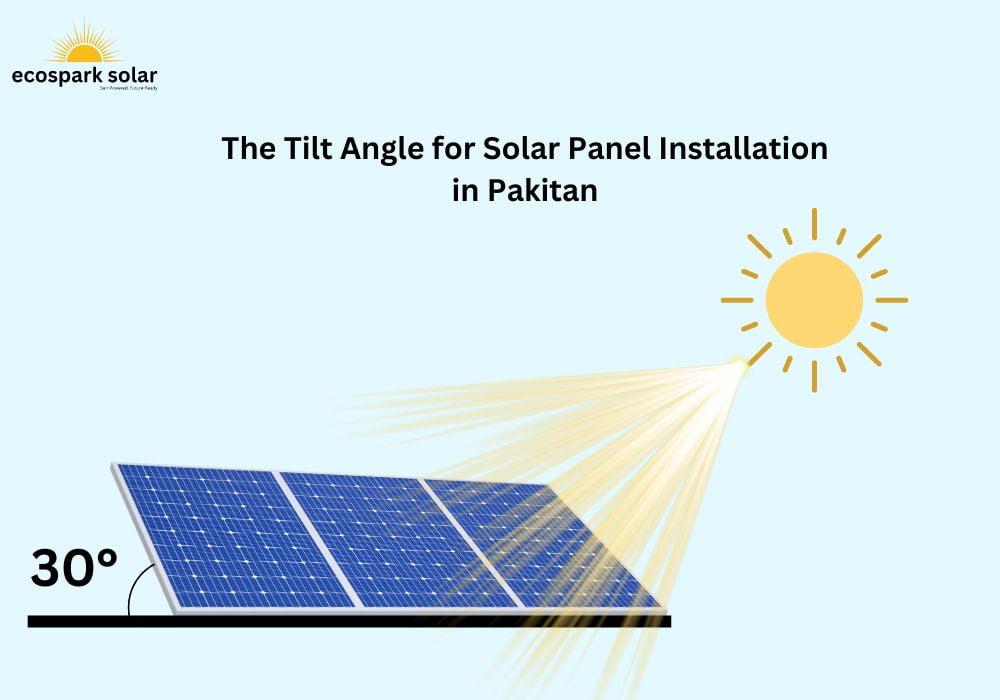
Imagine holding a book in your hand and tilting it vertically toward the sun. The angle at which you tilt the book is similar to the tilt angle of solar panels. It refers to how much the solar panels are tilted or slanted from a flat position. This angle is crucial because it helps the panels catch as much sunlight as possible.
We need to find the right tilt angle for the solar panels to make the most out of the sun’s energy. If the panels are tilted too much, they might not receive enough sunlight. On the other hand, if they are not tilted enough, they might not capture as much sunlight as they could.
Direction of Solar Panels (Azimuth)
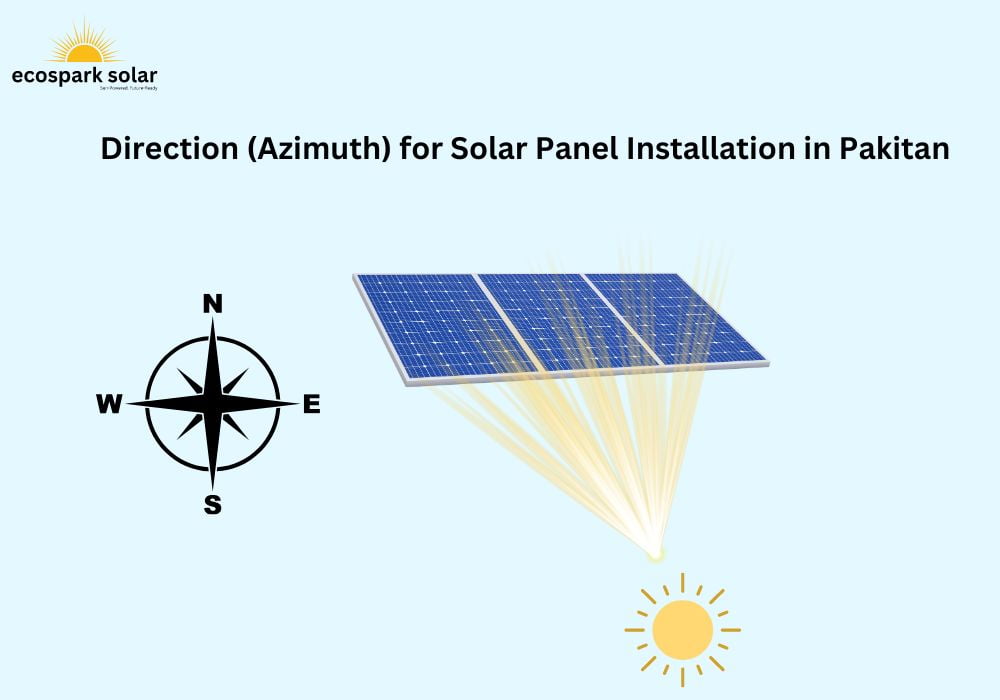
Azimuth refers to the specific direction in which solar panels face the sun. It helps us determine the best angle at which the panels should be positioned to directly receive sunlight. By facing the right direction, the solar panels can soak up the most sunlight throughout the day.
To find the correct azimuth, we need to consider where we are on Earth. Different places have different angles at which the sun shines. For example, Pakistan is in the northern hemisphere, and the sun shines in the south, so you would want your solar panels to face toward the south. But for those who live in the southern hemisphere, such as Australia and New Zealand, the panels should face towards the north. This way, the panels can capture the sun’s rays and produce more electricity.
A solar system for everyone.
We’re customer-centric; we will find you a solution within your budget. Whatever your project size, you can always save with Ecospark Solar.
What’s the Tilt Angle for Solar Panels in Pakistan?
The tilt angle (elevation angle) for Pakistan varies from 23 degrees to 37 degrees. The general guiding principle for calculating the tilt angle is to align it with the latitude of the installation location. That’s the theory. In reality, however, we install our systems at around 20-26 degrees across Pakistan. This is because, in Pakistan, the energy crisis hits hard in summer and if you want to make the most of your system in summer, you will have to lower the angle by 5-10 degrees.
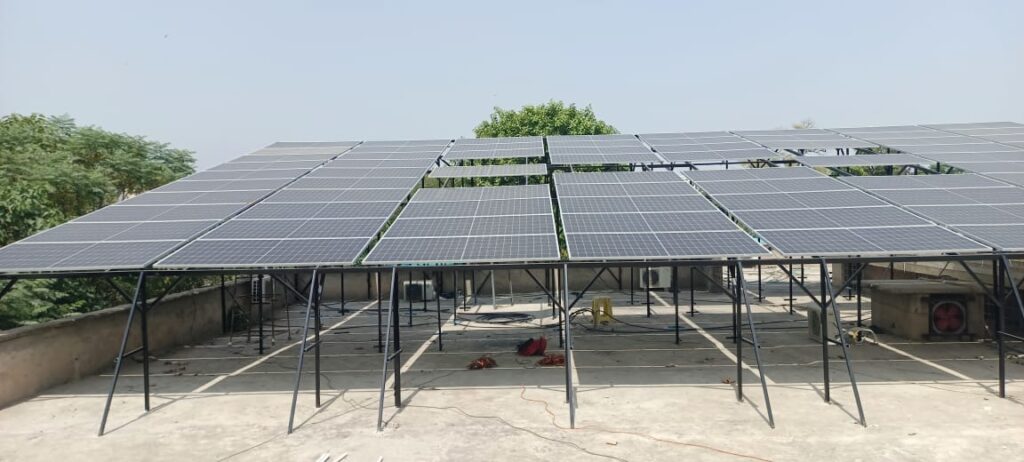
Latitude is the measure of distance from the equator and plays a significant role in determining the angle of the sun’s rays.
Here’s how you can calculate the tilt angle for solar panels in Pakistan:
a. Determine the Latitude of the Installation Location
A simple Google search would give you the latitude of your location. You can also determine this from the world map. For instance, in Islamabad, the latitude is approximately 30 degrees. You can find the latitude of your area in this world map for Pakistan. Again, note that the actual angle on which your system will be installed will be less than this angle. We already discussed why it is like this in the section above.
b. Optimal Tilt Angle for Overall Production
To optimize energy production year-round, the recommended tilt angle generally equals the latitude. Therefore, the optimal tilt angle in Islamabad would be approximately 30 degrees.
c. Adjusting Tilt Angle for Seasonal Optimization
If you prefer to prioritize energy generation during specific seasons, you can slightly adjust the tilt angle. To increase production during the summer months, tilt the panels at the latitude minus 10-15 degrees.
For example, in Islamabad, you can tilt the panels at approximately 18.6-23.6 degrees. Conversely, to enhance production in the winter months, tilt the panels at the latitude plus 10 degrees, which would be around 40 degrees for Islamabad.
It’s important to note that while these guidelines provide a good starting point, additional factors may be needed, such as local climate conditions, shading analysis of your roof, and specific energy requirements.
Consulting with a professional solar company, like Ecospark Solar, or using specialized software can help refine the tilt angle calculation based on your specific location and goals.
Factors to Keep in Mind While Calculating Tilt Angle for Solar Panels in Pakistan
When calculating the tilt angle for solar panels on your rooftop, you need to take into account several factors. These factors include latitude, existing roof structure, and the time of the year.
a. Latitude of Your Area
As mentioned earlier, latitude is the deciding factor. Aligning the tilt angle with the latitude of the installation location is a general guideline for achieving optimal energy generation year-round. The angle is adjusted to correspond with the latitude to maximize exposure to the sun’s rays. The higher the latitude, the higher will be the tilt angle required to capture the most sunshine.
b. Existing Roof Structure of Your Home
The existing roof structure of your building is another important factor to consider when calculating the tilt angle. The type of roof, its orientation, and the available space for solar panel installation may influence the tilt angle you can achieve. In Pakistan, most of our roofs are flat. That means you will require an additional mounting structure to introduce the ideal tilt angle for your solar panels.
If your roof is already tilted at a certain degree, such as 30, you may just install solar panels without additional mounting structures.
c. Time of the Year
Now, the time of the year. Solar energy production varies throughout the year due to the changing position of the sun. To account for seasonal variations, it may be beneficial to adjust the tilt angle of the solar panels.
During the summer months, when the sun is higher in the sky, a lower tilt angle may be preferred to capture more direct sunlight. Conversely, in the winter months, when the sun is lower, a higher tilt angle can help increase solar energy production.
Keep the following in your mind:
To optimize overall production year-round, tilt your panels at your latitude. If you want more production in the summer, tilt your panels at your latitude minus 10-15°. Similarly, if you have a school that remains closed in the summer and want more production in the winter, tilt your panels at your latitude plus 10-15°.
What’s the Best Direction (Azimuth Angle) for Solar Panels in Pakistan?
The south. Since Pakistan is located in the northern hemisphere, the ideal direction for solar panels is typically 180 degrees, which corresponds to facing south.
When it comes to calculating the direction, or azimuth angle, for solar panels in Pakistan, it is important to consider the geographical location and the position of the sun throughout the day. In the northern hemisphere, the sun appears to move in an arc across the southern sky throughout the day. By orienting the solar panels towards the south, they can receive the maximum amount of sunlight and generate the highest energy output. South-facing panels capture sunlight for the longest duration during the day, from morning to evening, optimizing energy production.
It is important to note that there may be specific cases where facing slightly east or west of true south could provide certain advantages, such as optimizing energy production during certain times of the day or mitigating specific shading concerns. For example, again, a school usually remains open only in the first half of the day, so you can target the first half by installing solar panels facing south-east.
However, as a general guideline for solar panel installations in Pakistan, aiming for an azimuth angle of 180 degrees (south-facing) will typically yield the best results.
Frequently Asked Questions (FAQs) About Tilt and Azimuth in Pakistan
What is the best tilt angle for solar panels in Islamabad?
The latitude of Islamabad is approximately 33.6 degrees, the optimal tilt angle for solar panels in Islamabad would be around 33.6 degrees. This angle allows the panels to capture sunlight effectively throughout the year and maximize energy production. You can do plus-minus for optimizing energy production during specific seasons.
What is the best tilt angle in Karachi for solar panels?
Since Karachi is situated at a latitude of around 24.9 degrees, the recommended tilt angle for solar panels in Karachi would be approximately 24.9 degrees.
What is the best tilt angle for solar panels in Peshawar?
The optimal tilt angle for solar panels in Peshawar would be 34 degrees. You can go 10 degree plus-minus to optimize energy production for summers and winters.
What is the best tilt angle for solar panels in Lahore?
The right tilt angle for solar panels installation in Lahore is 31 degrees. Most installers place panels at a 30 degrees, which is fine for year-round energy optimization. You can also install them 10 degree plus-minus to optimize energy production for summer and winter.
Which direction is best for solar panels in Pakistan?
For solar panels in Pakistan, the ideal direction is generally south-facing, which corresponds to an azimuth angle of approximately 180 degrees. Since Pakistan is located in the northern hemisphere, facing the solar panels towards the south maximizes their exposure to sunlight throughout the day. South-facing panels capture the most sunlight and generate the highest energy output.
How much does tilt affect solar panels?
The tilt angle of solar panels significantly affects their energy production. The tilt angle determines how directly the panels receive sunlight. By adjusting the tilt angle to align with the latitude of the installation location, solar panels can capture sunlight optimally. Deviating from the recommended tilt angle may result in a decrease in energy generation. While small deviations may have minimal impact, significant deviations from the optimal tilt angle can significantly reduce the efficiency and overall output of the solar panels.
What is the azimuth angle for solar panels in Pakistan?
Azimuth refers to the direction of solar panels. As a general guideline, aiming for an azimuth angle of approximately 180 degrees (south-facing) is ideal for most locations in Pakistan.
Additional Resources You Might Be Interested In:
- Peak Sun Hours in Pakistan (Islamabad, Punjab, KPK, Baluchistan and Sindh)
- Net Metering in Pakistan: An All-In-One Simple Guide
- Net Metering Rates in Pakistan (NEPRA Net Metering Tariff – 2023)
- IESCO Net Metering (Net Metering in Islamabad | Rawalpindi)
- Comparing Solar Installation Types: On-Grid vs. Off-Grid vs. Hybrid Solar

